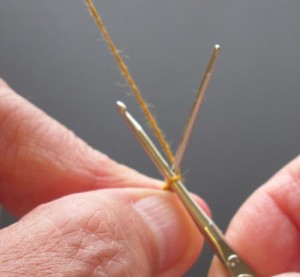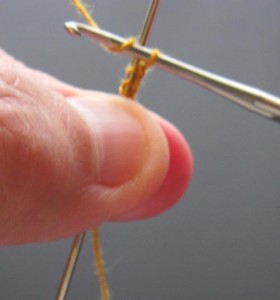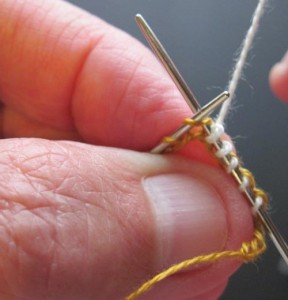This second provisional cast on method crochets waste thread loops directly onto a knitting needle. Then the loops are knitted with the actual project thread to create the cast on row.
In last week’s article on Starting the Lace Doily Edging: Provisional Cast On, I described the Crochet Chain Provisional Cast On as just one of the methods you could use to start your doily edging. I didn’t want to leave anyone out of the loop if you did not already have a favorite provisional cast on. As long as you end up with 15 loops of lace thread ready to be knitted on your needle after completing your provisional cast on, any method to get there is fine as far as I know. (I know I am tempting fate by someone coming up with something weird, lol.)
For those who do not already have a favorite method, I suggested the crochet chain method because in my years of teaching and writing pattern instructions, I’ve found that it is the easiest to describe and for people to understand in the least amount of time. Especially for the few stitches such as being used in this lace edging, it works well enough.
There is also another method that involves crochet that is quite easy. Instead of making a crochet chain first, a series of waste thread loops are crocheted directly onto the knitting needle itself.
Start with a slip knot loop on the crochet hook. * Then with crochet hook to right of knitting needle, bring long end of thread under tip of knitting needle and to the left.
Then wrap thread around hook, and draw a loop over the knitting needle from left to right and through the loop on the crochet hook. You now have one waste thread loop on the knitting needle and a new loop on the crochet hook. Repeat from * until you have the same number of waste thread loops on the knitting needle as cast on stitches required.
During this part of the process, I usually feel like I need 3 hands! If this is the way you feel, you are not alone, lol. It does help to use the fingers of your left hand to stabilize the starting short thread tail as well as keep the waste thread loops from twisting around the knitting needle as additional loops are subsequently added.
After completing all needed waste thread loops, as with the crochet chain method you can make a few extra crochet chain stitches (leave these detached, i.e. not made around the knitting needle). Then bring end of thread through last chain stitch to avoid unraveling. This end is the “zipper” end of the crochet chain.
What you’ve completed so far is NOT the first row of provisional cast on. All that has happened so far is that you have put what would have been the “bumps” of the back side of a crochet chain directly onto a knitting needle. Since the bumps are already conveniently waiting on the knitting needle, this avoids you having to find and pick up through them as in the Crochet Chain method. You’ve traded off the convenience of these waste thread loops awaiting you on the knitting needle vs. the inconvenience of feeling like you need 3 hands to get them there, lol. It does get easier with practice, though, so please don’t feel like I am deterring you.
To complete the Provisional Cast On, all you need to do is knit with your lace thread into each waste thread loop on the knitting needle.
Tip: As mentioned in the pattern instructions, this provisional cast on row acts as the last 15 stitches of the 12th row of the stitch pattern. Even though the 12th row is normally purled, it doesn’t matter for a Provisional Cast On row of this type whether you knit or purl! Trust me on this and don’t make it harder on yourself than needed.
Let me know what you think. I hope these tutorials, tips and techniques will help expand your knitting horizons not only for the lace projects we are doing in Bits of Lace, but for all your knitting enjoyment.





 HeartStrings FiberArts
HeartStrings FiberArts Knitting Bits of Lace on Facebook
Knitting Bits of Lace on Facebook Ravelry Store
Ravelry Store
Great tutorial! An excellent way to do the provisional cast-on that I have never seen before. Very helpful. Thanks.
Hmmmmm…hadn’t seen it done that way before. Thanks!